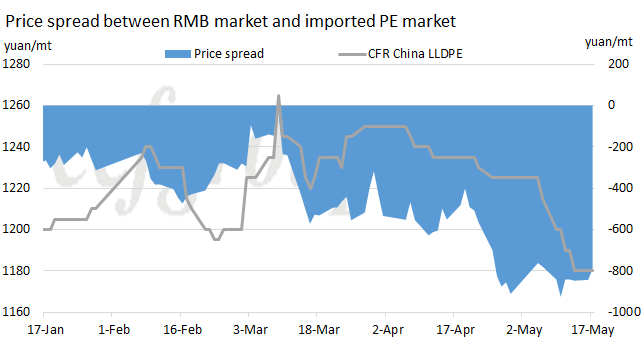Imported PE market affected by the depreciation of Chinese yuan
After the Labor Day holiday, China domestic PE market moves higher first and then fluctuates, while the imported PE market has maintained the slightly downward trend. Generally speaking, RMB market and imported PE market have always kept the same trend, and sometimes the imported PE market may lag slightly behind the RMB spot market, and it is relatively rare for a small deviation this time.
![]{`MSS7WCD(W])~J5JR~A}7.png ]{`MSS7WCD(W])~J5JR~A}7.png](https://pic.ccf.com.cn/2022/05/20220518113142512.png)
Affected by many factors, the current imported PE market may continue to weaken. On May 16, prevailing offers for LLDPE (MFR: 2) were at $1,170-1,190/mt, LDPE (MFR: 2, with anti-blocking agent) offers at $1,480-1,500/mt, and HDPE film at around $1,170-1,190/mt, load in Jun, CFR China main ports.
![US2QC4AXL1Q[}0YO5]GCY[3.png US2QC4AXL1Q[}0YO5]GCY[3.png](https://pic.ccf.com.cn/2022/05/20220518113204827.png)
First of all, in the past month, RMB continues to depreciate against US dollar, falling all the way from around 6.3 in mid-April, especially in the afternoon of May 12, the exchange rate once fell below the 6.8 mark for the first time since September 2020. The depreciation of the RMB has directly led to a substantial increase in the procurement cost of foreign first-hand traders.

Secondly, due to the continuous depreciation of RMB, the procurement costs of first-hand traders have increased. However, the RMB market continues to fluctuate, resulting in a continuous enlargement of the price spread between RMB market and imported PE market. Taking LLDPE as an example, the current price spread is around $800/mt, which has also weighed on the imported PE market to a certain extent.
From the perspective of downstream, since the price spread between RMB market and imported PE market is too large, the overall purchasing mood in the downstream is relatively bearish, and they prefer to purchase yuan-denominated materials and get the tax refunded to reduce their own costs. Therefore, the high price spread also forces foreign traders to cut their offers. On the other hand, affected by the poor demand during the off-season and the epidemic in East China, several ships have difficulty in landing and some plants shut down, the overall procurement rhythm has been disrupted, most orders have been delayed. Most medium and large plants have their own stable sources of supply, and their purchasing power for the external goods has dropped sharply, resulting in a more sluggish trading performance in the imported PE market.
On the whole, the depreciation of RMB will continue to affect the imported PE market, and the long-standing high price spread is basically impossible to narrow in the short term. Coupled with the weak demand, it is difficult for the imported PE market to improve, and the overall market price will continue to weaken.
- Top keywords
- Cotton Price
- Cotton Futures Price
- Cotton Futures
- CZCE
- PTA Futures Price
- Chemical Fiber
- Polyester Prices
- Wool price
- PTA Futures
- Shengze Silk
- China
- Yarn Price
- price
- China Textile City
- Fibre Price
- Benzene Price
- Cotton
- Index
- Cotton Index
- PTA
- fabric price
- NYMEX
- Top 10
- textile industry
- Spot Cotton
- Cotton Yarn
- Polyester Price
- Futures
- PTA Price
- cotton yarn price

